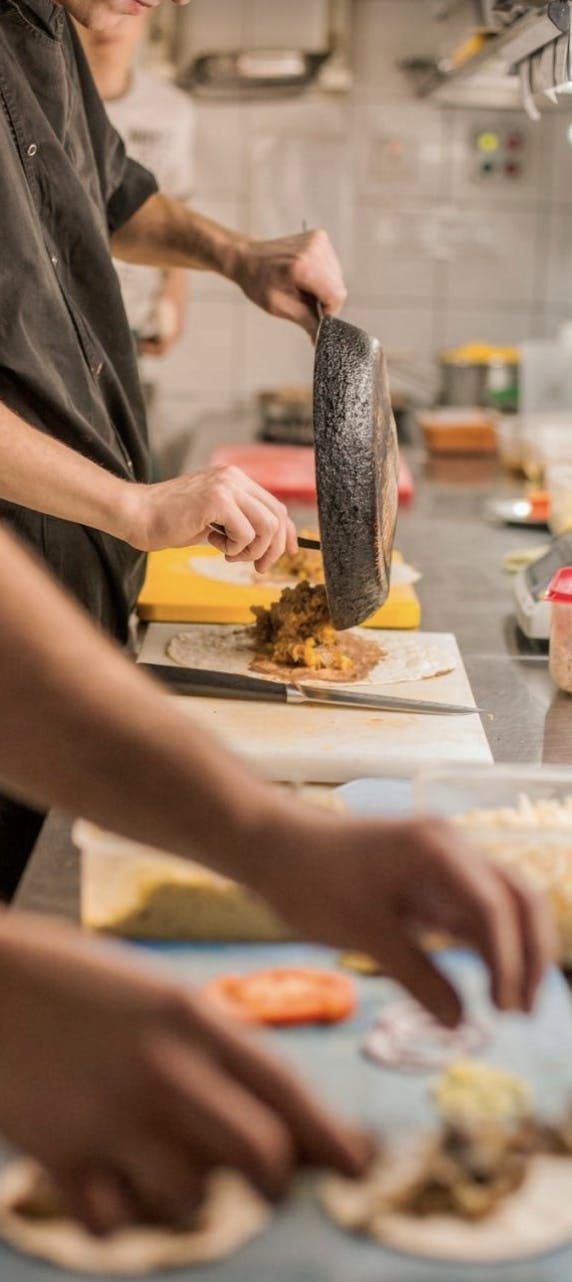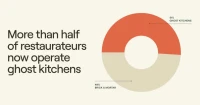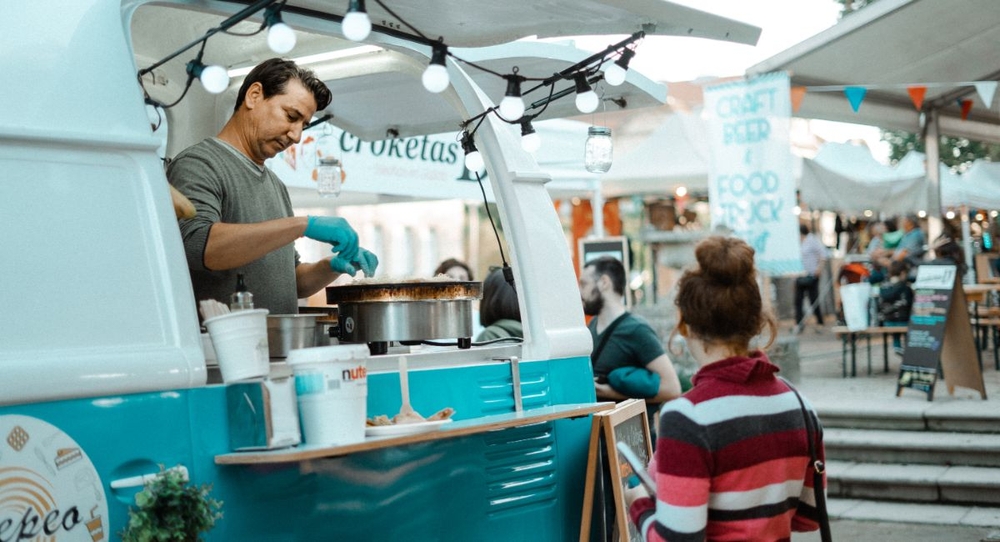Launch your Virtual Restaurant: A complete guide to success
Table of Contents
CloudKitchens
How many tacos can be delivered from a 1000sqft restaurant?
The same amount as a 200sqft ghost kitchen.

With demand for food delivery soaring, there’s never been a better time for beginner and established restaurateurs to expand their reach. Opening a restaurant requires many decisions, and one of the most important is your business model.
Virtual kitchens are at the forefront of the delivery-only restaurant revolution, giving food entrepreneurs at all career stages a piece of the action.
Not only is this concept accessible to a wide range of business owners, but it also has some serious advantages over a traditional restaurant. Follow along if you’re ready to get a leg up in this sizzling industry.
What is a virtual restaurant?
A virtual restaurant is an extension of your brand that’s dedicated to getting your non-virtual food concepts into the hands of to-go customers. In other words, this model eliminates the pressure of curating a complete dine-in experience, allowing you to focus on your food concept for delivery only.
A virtual kitchen can operate out of your existing brick-and-mortar restaurant or a collaborating restaurant or commercial kitchen.
Now more than ever, people want the option of restaurant-quality food from the comfort and safety of their homes. In fact, it’s estimated that more than 185 million people will be using online food delivery services by 2025. Virtual restaurants provide restaurant owners with a flexible, low-capital investment option that handles all incoming delivery orders.
A good example is our New York Ghost Kitchens, where restaurant owners can expand their businesses in some of the region’s most iconic locations.
Benefits of going virtual
If you already have a large kitchen space, a lull during off-peak hours, an idle food truck, or an interest in creating buzz around your food with brand collaborations, a virtual restaurant might be for you.
Before you take the plunge, let’s explore a handful of perks that are unique to virtual restaurants:
- Low, low cost: If operating out of an existing restaurant, you’re looking at no additional rent and virtually zero start-up costs.
- Flexibility: Again, if you’re already in a secured kitchen space, there are no extra leases to worry about you can launch anytime your virtual restaurant is ready to go live!
- Mobility: Want to take your new restaurant concept to new customers? A virtual kitchen provides you with the flexibility you need to reach more hungry customers searching online.
- Low entry barrier: Even entrepreneurs with fewer resources or capital can get in on this opportunity. Plus, by creating a relationship with an established restaurant, restaurateurs can take advantage of their collaborator’s existing audience, winning new and local customers.
- Room for creative expansion: Say your restaurant is the go-to neighborhood spot for brunch, but you want to expand your offerings. With a virtual restaurant, you can test-drive your hand-cut pasta and Tuscan chicken without opening your doors for a full dinner service. It’s also a low-risk way to try out an entirely new restaurant concept without the overhead costs of an additional storefront.
With so much potential for a high return on investment, you might already be itching to open your virtual doors. But first, you’ll need to draw up a detailed business plan. Follow along below as we show you how to start a virtual restaurant.
How to start a virtual restaurant: 7 steps
So, you’ve decided a virtual restaurant is right for you, but how do you go about realizing your plan? These seven steps explain how to start a virtual kitchen so that you can launch your new restaurant concept off the ground with gusto.
1. Create a concept
If you’re a chef or culinary entrepreneur, you likely have a variety of ideas for potential restaurant concepts. Pick the one you’re most confident and passionate about and build a menu that gives life to your vision.
When it comes to virtual restaurants, you’ll want to take into account what will travel well. That way, you’ll be able to preserve the integrity of your food as it wings its way from the kitchen to your customers.
If you want to stay true to the concept of your original brick-and-mortar, decide what dishes will be included on your virtual menu and whether you want to introduce delivery platform-only specials. Whatever you choose, one of the draws of a virtual restaurant is offering a slightly remixed version of your dine-in menu, available exclusively through a virtual brand platform.
2. Decide on your target audience
If your virtual restaurant’s concept differs significantly from your established brand, you’ll need to determine the target audience for your new offerings. When you have a clear vision of who’s behind the screen that’s connecting hungry locals to your food, you’ll be able to:
- Curate your menu accordingly–Whether you’re hoping to cater to at-home diners in search of home-cooked comfort food or upscale fusion cuisine, researching your target audience’s likes and dislikes will help you craft a menu that hits the spot every time.
- Settle in an ideal location–Do you plan to cast a wider geographical net to maximize your food’s reach or keep your cooking closer to home? Whatever you decide, make sure your kitchen and delivery services are equipped to support the needs of your intended locales.
- Optimize your marketing efforts–The more you know about your current and prospective patrons, the better you’ll be able to get your brand’s message out. Learn about their preferred communication channels, what type of content they typically consume, and what times they might be tuning into your platform to order. From there, you can build a digital marketing campaign that’s sure to catch your customers’ eyes.
3. Set your kitchen up for success
To implement new menu items and an additional source of revenue, you may need to update or reorganize your kitchen. This can be as simple as adding new items to your produce order or designating an under-utilized area to execute your to-go options.
If you don’t have room in your existing kitchen, consider:
- Saving up for a kitchen addition or remodel that’ll support your new vision
- Utilizing a food truck fitted with everything you need to carry out your concept
- Tapping into your fullest potential by setting up shop in a ghost kitchen, a low-capital investment that could effortlessly expand your business in as little as a month
4. Build your brand
Even a virtual restaurant needs attractive, eye-catching branding. Since your business is online, you’ll want to ensure your digital marketing presence is strong across all channels.
If you have a graphic or web designer on your team, they can help craft an online presence that matches your vision and offers a user-friendly experience to your clientele. You can also work alongside a copywriter to ensure your brand’s voice is clear, tailored appropriately to your audience, and cohesive across all digital channels.
If you’d prefer not to make a full-time hire, consider enlisting the help of a freelancer who can work with you on a project-by-project basis.
5. Perfect your packaging
Consider the optimal way to package your to-go goods so that they arrive tasting—and looking—as good as they would straight from the line. This is also an opportunity to consider your environmental footprint. Using eco-friendly packaging is not only a win for the earth–conscious consumers will appreciate your thoughtful choices, too.
6. Connect to tech
Third-party delivery order services help deliver your food seamlessly and are among the most popular ways consumers order takeout. Plus, this kind of software will be key for your kitchen’s visibility.
Decide which delivery platforms you want to partner with and set up an in-restaurant station for receiving orders. Research the most streamlined way to manage multiple online platforms to help your kitchen and expo staff expedite orders with ease and efficiency.
Read More: Restaurant Technology: Boost your business with the best technology trends
7. Launch your virtual restaurant
Once you have your concept refined, your menu optimized, and your operations ironed out, you’re ready to start getting food into the hands of new customers. Go live and get busy on social media to help promote your new brand—and, of course, get cooking!
But don’t wait until launch day to start generating buzz around your brand. Instead, take a few of these proactive measures:
- Snap some carefully curated pictures of your dishes and start sharing them on social media in the weeks leading up to opening day.
- Offer a special launch-day (or launch-week) discount, such as free delivery, a buy-one-get-one deal, or a free appetizer with a minimum purchase. With hard-to-pass-up incentives like these, local diners who may be unfamiliar with your eatery will have no choice but to give it a try.
Whet your appetite for success with CloudKitchens
Now that you’ve begun to master the how-to of virtual restaurants, it’s time to let your passion and creativity shine. Sink your teeth into a mouthwatering concept, learn about the difference between a ghost kitchen vs. virtual kitchen, settle on the specifics of your brand, and let CloudKitchens support you through the journey.
Instead of overspending on a costly brick-and-mortar location, CloudKitchens allows you to have full access to kitchens with specialized equipment, on-site support staff, delivery software, and more. That way, you’ll be able to continue innovating your cuisine and expanding your reach while keeping overhead costs to a minimum.
Sign up for one of our commercial kitchens in Austin, NYC, or any other part of the country! Now is the perfect time to get in on the ground floor of the virtual culinary scene. We have locations in most major metropolitan areas in the US and even a ghost kitchen in Toronto! Now is the perfect time to get in on the ground floor of the virtual culinary scene. Tour one of our kitchens today to get started.
Explore ghost kitchen locations across the US:
- Ghost kitchens in San Francisco
- Ghost kitchens in LA
- Ghost kitchens in NYC
- Ghost Kitchens in Toronto
- Ghost Kitchens in Atlanta
- Ghost Kitchens in Dallas
- Ghost Kitchens in Chicago
- Ghost Kitchens in Denver
- Ghost Kitchens in Miami
| DISCLAIMER: This information is provided for general informational purposes only and the content does not constitute an endorsement. CloudKitchens does not warrant the accuracy or completeness of any information, text, images/graphics, links, or other content contained within the blog content. We recommend that you consult with financial, legal, and business professionals for advice specific to your situation. |
Read more:
- Starting a Pop-up Restaurant: A Comprehensive Guide
- Essential tips for safe and efficient food storage in your kitchen
- Waste Management: best strategies for your restaurant
- Mastering demand management: Strategies for handling peak delivery periods
- How to Start a Ghost Kitchen: Essential Tips for Success
- Start a food delivery service: your complete how-to guide
Sources:
- Lunchbox. How to Start a Virtual Restaurant: Your 10-Step Guide & Expert Tips. https://lunchbox.io/learn/ghost-kitchens/virtual-restaurant
- Toast. 20 Food Delivery Statistics to Know in 2022 https://pos.toasttab.com/blog/food-delivery-statistics#:~:text=The%20pandemic%20skyrocketed%20delivery%20 sales,food%20delivery%20services%20by%202025.
- HoodFilters.com. Is the Ghost Kitchen or Virtual Kitchen Model in Your Restaurant’s Future?https://www.hoodfilters.com/foodservice-blog/2020/12/14/%C2%ACis-the-ghost-kitchen-or-virtual-kitchen-model-in-your-restaurants-future
- Business of Apps. Food Delivery App Revenue and Usage Statistics (2022). https://www.businessofapps.com/data/food-delivery-app-market/
More insights & stories
There’s more where that came from.
Get in the know and check out our additional insights



